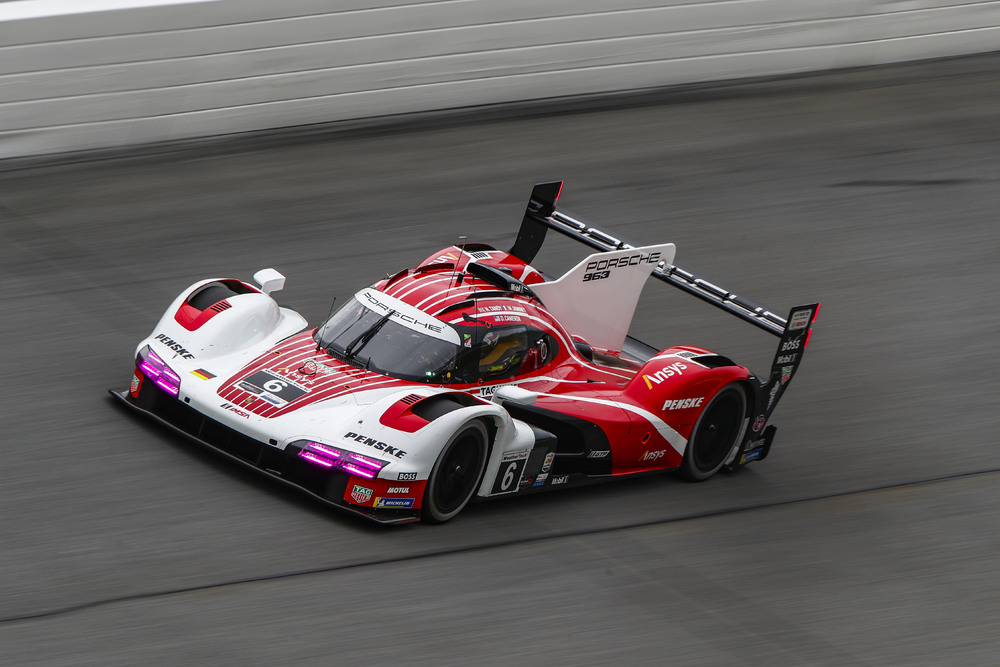The Porsche 963 banks on powerful DNA from RS Spyder and 918 Spyder
The new Porsche 963 makes its official race debut at the 24 Hours of Daytona in the US state of Florida (28/29 January). Prior to this, the hybrid vehicle had covered more than 33,000 kilometres at tests and the so-called Roar at Daytona. In the final qualifying session, the two works cars qualified on positions two (No. 7) and nine (No. 6). The type designation alone makes the path clear that the Stuttgart sports car manufacturer is pursuing with the Porsche 963: The new car for the top classes Hypercar (FIA WEC) and GTP (IMSA) puts out around 500 kW (680 PS) in race mode and is expected to continue the successful legacy of the Porsche 962. The legendary model from the Group C era achieved something unprecedented in 1986 and 1987: in both seasons, the cars clinched overall victory at Le Mans, Sebring and Daytona. Porsche holds a record in all three races, with 18 wins at the American endurance classics and 19 overall victories at Le Mans. Hopes are high for victory number 20 on the occasion of the 100th anniversary of the French 24-hour race in June 2023. The new Porsche 963 is ready to tackle this season’s great classics.
Chassis: LMP2 basis from Multimatic with the iconic Porsche brand identity
The regulations stipulate that all new vehicles for the LMDh category must be based on an LMP2 chassis. Four potential partners are available for such a project: Multimatic, Oreca, Dallara and Ligier. After an in-depth evaluation, Porsche made the early call to work with Multimatic. As the largest of the four LMP2 manufacturers, the automobile technology company based in Toronto (Canada) also contributes components for the Porsche 911 RSR, the Porsche 911 GT3 R and Porsche 911 GT3 Cup. In addition to the existing business relationship, the enormous production capacities also spoke in favour of Multimatic – a critical factor given that the Porsche 963 will also be raced by customers on both sides of the Atlantic in its first year of competition.
The new racing prototype is easily recognisable as a real Porsche. Its design combines modern elements with historic roots. The front section is reminiscent of the soft shapes of the legendary 956 and 962, while the continuous illuminated strip is a salute to the characteristic hallmark of the current 992-generation nine-eleven model series. “The regulations give us a performance window,” explains Christian Eifrig, technical project manager of the Porsche 963. “In terms of downforce and lap times, the vehicle must remain within a defined performance range as prescribed by the regulations. This is the only way for the sport’s governing bodies to equalise the cars of different manufacturers using Balance of Performance,” Eifrig continues. The so-called BoP, a classification rating for different vehicles in the new top classes, ensures a level playing field and thrilling racing. Factors such as minimum weight, maximum revs per minute or energy per stint make the vehicles equivalent in terms of performance. “It’s quite challenging to reach this performance window. At the same time, it’s about achieving the typical Porsche look. We had the difficult task of finding the perfect compromise between efficient aerodynamics and an immediately recognisable design language.” For the ACO and FIA governing bodies to accept the so-called brand identity, it must also meet many other criteria. The Porsche 963 received immediate approval.
V8 turbo engine: Modern unit based on the Porsche RS Spyder
While the regulations specify that the hybrid components and the gearbox must be cost-efficient standardised components, it allows great leeway in choosing the combustion engine. In principle, the following applies: Power output is capped at 520 kW (707 PS) with the minimum weight set at 180 kilograms including the periphery. In late 2020, Stefan Moser, as the head engineer responsible for the Porsche 963 powertrain, and his 18-strong team opted for the 4.6-litre engine from the Porsche 918 Spyder. This hybrid-powered super sportscar debuted in early September 2013. Shortly before its premiere, it became the first production sports car to turn a sub-seven-minute lap of the Nürburgring-Nordschleife. Its powerful V8 offers excellent durability, enormous stiffness and dry sump lubrication. “The engine features a flat crankshaft and has a very short stroke,” explains Moser. “This allowed us to mount it very low, which gives us a low centre of gravity and optimum linkage points for the suspension and gearbox. Although the engine was not a supporting element in the 918, its basic rigidity was relatively high – and this also suits us very well.”
Powering the Porsche 918 Spyder is a highly efficient naturally aspirated engine without turbocharging. In the LMDh prototype, the power unit runs in conjunction with two turbochargers from the Dutch manufacturer Van der Lee, which increases the ambient pressure by just 0.3 bars. The charger units are mounted on the ‘hot side’, in the 90-degree opening of the V-geometry. “The good thing is that the engine retains its basic characteristics as a naturally aspirated unit and has a swift throttle response. The relatively low boost pressure builds quickly and therefore there is no so-called turbo lag,” reveals the developer from the Porsche Motorsport Centre in Flacht. Converting the production engine to feature turbo technology was easy: around 80 percent of all components come from the 918. Some components required additional reinforcement to make the 963 engine a supporting element. Another advantage of a 4.6-litre engine: in the 918 Spyder, Porsche had already designed the V8 to work with a hybrid system.
The standardised components of the electric boost system are supplied by the manufacturers Bosch (motor generator unit, electronics and software) and Williams Advanced Engineering (high-voltage battery). The so-called motor generator unit (MGU), which is responsible for the power output and recuperation under braking at the rear axle, works in direct interaction with the standard gearbox from the Xtrac brand. The MGU sits in the bell housing between the combustion engine and the gearbox. The hybrid’s entire electrical system produces up to 800 volts. The uniform battery has an energy capacity of 1.35 kWh, which can be mobilised at any time under acceleration. An output of 30 to 50 kW (40 to 68 PS) is available in short bursts but does not change the overall output of the powertrain. When the thrust of the MGU kicks in, the power of the combustion engine, which can reach over 8,000 rpm (depending on the BoP), automatically decreases. The regulations stipulate the power output precisely.
The lineage of the 4.6-litre twin-turbo V8 sporting the Porsche internal designation 9RD can be traced back to the RS Spyder. In the hands of the former Porsche customer team Penske, the racing vehicle won all titles in the LMP2 class of the American Le Mans Series between 2006 and 2008. At the time, the engine in the distinctive yellow and red prototype had a displacement of 3.4 litres. The design and concept, however, still satisfy the highest demands of modern motorsport. “The V8 engine can also run on CO2-optimised fuel, or so-called bio-based refuel,” says a pleased Stefan Moser. In this area, Porsche has played a pioneering role with the introduction of environmentally friendly fuels in the Porsche Mobil 1 Supercup since the 2021 season. The insights gained there with the 911 GT3 Cup assist with the optimum running of the new Porsche 963.
Technical baseline data Porsche 963
Length/Width/Height: 5,100/2,000/1,060 mm
Wheelbase: 3,148 mm
Minimum weight: 1,030 kg
Top speed: >330 km/h
Technical data 9RD engine
Design: V8 engine
Displacement: 4,593 cc
Charging: 2 turbochargers
Cylinder bank angle: 90 degrees
Bore: 96 mm
Stroke: 81 mm
Output: > 515 kW (700 PS)
RPM: > 8,000




Comments
Log in to comment the article